Experimental Study on the Strength and Hydration Products of Cement Mortar with Hybrid Recycled Powders Based Industrial-Construction Residue Cement Stabilization of Crushed Aggregate
Abstract
1. Introduction
2. Materials and Methods
2.1. Materials
2.2. Experimental Design
2.3. Preparation of Mortar and Paste Samples
2.4. Sample Testing
3. Results and Discussion
3.1. Particle Size Distributions
3.2. Chemical and Mineral Compositions
3.3. Micro-Structure Analysis
3.4. Mechanical Properties Analysis
3.4.1. Flexural Strength
3.4.2. Compressive Strength
3.5. Further Microstructural Analysis
3.5.1. Effect of the HRP-I on the Microstructure of Cement-Fly Ash Mortar
3.5.2. Effects of HRP-I on the Hydration Products of Cement Paste
4. Conclusions
- (1)
- HRP has specific activities and can be used as auxiliary cementitious material to replace some cement. In the presence of fly ash with increasing HRP content, the strength of the cement mortar first increased and then decreased, and the early strengths of the cement-mortar specimens with single RBP were better than those of the cement-mortar specimens with RCP. When the single content was lower than 15%, the maximum increase in 3 d compressive strength was 19.08%, and the maximum decrease in 28 d compressive strength was 2.39%.
- (2)
- HRP can be used as a mineral admixture to replace some of the fly ash. They were mixed with a mass ratio of 3/2 to form the HRP, which effectively improved the strength of the mortar specimen. When the RBP, RCP, and fly ash were mixed with the mass ratio 21/14/65, the flexural strength of the mortar was 1.51 times higher than that of the cement-fly ash specimen, and the compressive strength was 1.56 times higher at 28 d.
- (3)
- In the presence of fly ash, the HRP mainly exerted the microaggregate effect and promoted the cement hydration reaction, which significantly improved the microstructural compactness of the mortar and the thickness of the C-S-H on the surfaces of the fly ash particles.
- (4)
- The pozzolanic effect operating on the HRP in the later stages reduced the intensities of the CH diffraction peaks. The crystal plane orientation index R with a diffraction angle of 34.0° (101) was consistent with the evolution law for compressive strength.
Author Contributions
Funding
Informed Consent Statement
Data Availability Statement
Conflicts of Interest
References
- Sousa, V.; Bogas, J.A. Comparison of energy consumption and carbon emissions from clinker and recycled cement production. J. Clean. Prod. 2021, 306, 127277. [Google Scholar] [CrossRef]
- Ali, A.A.; Abd, E.M.; Abd, E.; Esraa, M.A. Reuse of waste marble dust in the production of cement and concrete. Constr. Build. Mater. 2014, 50, 28–41. [Google Scholar] [CrossRef]
- Wang, C.T.; Zhang, P.; Guo, J.J.; Zhang, H.S.; Wang, T.Y. Effect of municipal solid waste incineration ash on microstructure and hydration mechanism of geopolymer composites. Buildings 2022, 12, 723. [Google Scholar] [CrossRef]
- Mehta, P.K.; Gjørv, O.E. Properties of portland cement concrete containing fly ash and condensed silica-fume. Cem. Concr. Res. 1982, 12, 587–595. [Google Scholar] [CrossRef]
- Rafieizonooz, M.; Mirza, J.; Salim, R.M.; Hussin, M.W.; Khankhaje, E. Investigation of coal bottom ash and fly ash in concrete as replacement for sand and cement. Construct. Build. Mater. 2016, 116, 15–24. [Google Scholar] [CrossRef]
- Abellan-Garcia, J.; Iqbal, K.M.; Abbas, Y.M.; Martínez-Lirón, V.; Carvajal-Muñoz, J.S. The drying shrinkage response of recycled-waste-glass-powder-and calcium-carbonate-based ultrahigh-performance concrete. Constr. Build. Mater. 2023, 379, 131163. [Google Scholar] [CrossRef]
- Karalar, M.; Özkılıç, Y.O.; Aksoylu, C.; Sabri, M.M.S.; Beskopylny, A.N.; Stel’makh, S.A.; Shcherban, E.M. Flexural behavior of reinforced concrete beams using waste marble powder towards application of sustainable concrete. Front. Mater. 2022, 9. [Google Scholar] [CrossRef]
- Hardjito, D.; Wallah, S.E.; Sumajouw, D.M.J.; Rangan, B.V. Factors influencing the compressive strength of fly ash-based geopolymer concrete. J. Civil Eng. Dimen. 2005, 6, 88–93. [Google Scholar]
- Nurudinn, M.F.; Nooriza, A.S. Effects of Geopolymer Concrete Fly Ash Based on Alkali Silica Reaction (ASR). Appl. Mech. Mater. 2014, 567, 405–410. [Google Scholar] [CrossRef]
- Imtiaz, L.; Kashif-ur-Rehman, S.; Alaloul, W.S.; Nazir, K.; Javed, M.F.; Aslam, F.; Musarat, M.A. Life cycle impact assessment of recycled aggregate concrete, geopolymer concrete, and recycled aggregate-based geopolymer concrete. Sustainability 2021, 13, 13515. [Google Scholar] [CrossRef]
- Javed, M.F.; Durrani, A.A.; Kashif Ur Rehman, S.; Aslam, F.; Alabduljabbar, H.; Mosavi, A. Effect of recycled coarse aggregate and bagasse ash on two-stage concrete. Crystals 2021, 11, 556. [Google Scholar] [CrossRef]
- Cho, Y.K.; Jung, S.H.; Choi, Y.C. Effects of chemical composition of fly ash on compressive strength of fly ash cement mortar. Construct. Build. Mater. 2019, 204, 255–264. [Google Scholar] [CrossRef]
- Fraay, A.; Bijen, J.M.; Haan, Y.M.D. The reaction of fly ash in concrete a critical examination. Cem. Concr. Compos. 1989, 19, 235–246. [Google Scholar] [CrossRef]
- Hassett, D.J.; Eylands, K.E. Heat of hydration of fly ash as a predictive tool. Fuel 1997, 76, 807–809. [Google Scholar] [CrossRef]
- Yoo, S.W.; Cho, S.H.; Jung, K.M. Quality control for coal combustion products in South Korea through assessed pozzolanic-activity index with long-term property tests. J. Mater. Cycles Waste Manag. 2017, 19, 647–711. [Google Scholar] [CrossRef]
- Sakai, E.; Miyahara, S.; Ohsawa, S.; Lee, S.H. Hydration of fly ash cement. Cem. Concr. Compos. 2005, 35, 1135–1140. [Google Scholar] [CrossRef]
- Zhang, X.C.; Meng, Y.B. Brief analysis on present situation of comprehensive utilization of fly ash in China. Inorg. Chem. Ind. 2020, 52, 1–5. [Google Scholar]
- Cochran, K.M.; Townsend, T.G. Estimating construction and demolition debris generation using a materials flow analysis approach. Waste Manag. 2010, 30, 2247–2254. [Google Scholar] [CrossRef]
- Xiao, J.Z.; Ma, Z.M.; Sui, T.B. Mechanical properties of concrete mixed with recycled powder produced from construction and demolition waste. J. Clean. Prod. 2018, 188, 720–731. [Google Scholar] [CrossRef]
- Xiao, J.Z.; Ma, Z.M.; Ding, T. Reclamation chain of waste concrete: A case study of shanghai. Waste Manag. 2015, 48, 334–343. [Google Scholar] [CrossRef]
- Wu, H.Y.; Zuo, J.; Zillante, G.; Wang, J.Y. Construction and demolition waste research: A bibliometric analysis. Architect. Sci. Rev. 2019, 62, 354–365. [Google Scholar] [CrossRef]
- Chen, H. Reuse research progress on waste clay brick. Procedia Environ. Sci. 2016, 31, 218–226. [Google Scholar] [CrossRef]
- Seror, N.; Portnov, B.A. Estimating the effectiveness of different environmental law enforcement policies on illegal C&D waste dumping in Israel. Waste Manag. 2020, 102, 241–248. [Google Scholar] [CrossRef]
- Thomas, C.; Brito, J.D.; Cimentada, A.; Sainz-Aja, J.A. Macro-and microproperties of multi-recycled aggregate concrete. J. Clean. Prod. 2020, 245, 103480. [Google Scholar] [CrossRef]
- Pacheco, J.; Brito, J.D.; Chastre, C.; Evangelista, L. Experimental investigation on the variability of the main mechanical properties of concrete produced with coarse recycled concrete aggregates. Construct. Build. Mater. 2019, 201, 110–129. [Google Scholar] [CrossRef]
- Li, L.; Xiao, J.; Xuan, D.; Poon, C.S. Effect of carbonation of modeled recycled coarse aggregate on the mechanical properties of modeled recycled aggregate concrete. Cem. Concr. Compos. 2018, 89, 169–180. [Google Scholar] [CrossRef]
- Ozbakkaloglu, T.; Gholampour, A.; Xie, T. Mechanical and durability properties of recycled aggregate concrete: Effect of recycled aggregate properties and content. J. Mater. Civ. Eng. 2018, 30, 04017275. [Google Scholar] [CrossRef]
- Evangelista, L.; Brito, J.D. Durability of crushed fine recycled aggregate concrete assessed by permeability-related properties. Mag. Concr. Res. 2019, 71, 1142–1150. [Google Scholar] [CrossRef]
- Pedro, D.; Brito, J.D.; Evangelista, L. Structural concrete with simultaneous incorporation of fine and coarse recycled concrete aggregates: Mechanical, durability and long-term properties. Construct. Build. Mater. 2017, 154, 194–309. [Google Scholar] [CrossRef]
- Guo, H.; Shi, C.; Guan, X.; Zhu, J.; Ding, Y.; Ling, T.C. Durability of recycled aggregate concrete-A review. Cem. Concr. Compos. 2018, 89, 251–259. [Google Scholar] [CrossRef]
- Shi, C.; Li, Y.; Zhang, J.; Li, W. Performance enhancement of recycled concrete aggregate—A review. J. Clean. Prod. 2016, 112, 466–472. [Google Scholar] [CrossRef]
- Bao, L.S.; Yu, L.; Wang, W.B.; Liu, K.T. Study on key technical index for construction of base course with cement fly-ash-flushed-by-seawater stabilized crushed-stones. Adv. Sci. Let. 2011, 4, 2547–2550. [Google Scholar] [CrossRef]
- Tang, Q.; Ma, Z.M.; Wu, H.X.; Wang, W. The utilization of eco-friendly recycled powder from concrete and brick waste in a new concrete: A critical review. Cem. Concr. Compos. 2020, 114, 103807. [Google Scholar] [CrossRef]
- Tao, M.; Hong, Y.P.; Ying, K.J.; Wang, Z.J. Comparison of technical properties of cement pastes with different activated recycled powder from construction and demolition waste. Cem. Concr. Compos. 2021, 121, 104065. [Google Scholar] [CrossRef]
- Kartini, K.; Rohaidah, M.; Zuranini, Z. Performance of ground clay bricks as partial cement replacement in grade 30 concrete. World Acad Sci. Eng. Technol. 2012, 6, 569–572. [Google Scholar] [CrossRef]
- Turanli, L.; Bektas, F.; Monteiro, P.J.M. Use of ground clay brick as a pozzolanic material to reduce the alkali–silica reaction. Cem. Concr. Res. 2003, 23, 1539–1542. [Google Scholar] [CrossRef]
- Afsinnia, K.; Poursaee, A. The potential of ground clay brick to mitigate Alkali-Silica Reaction in mortar prepared with highly reactive aggregate. Construct. Build. Mater. 2015, 95, 164–170. [Google Scholar] [CrossRef]
- Shao, J.H.; Gao, J.M.; Zhao, Y.S. Study on the pozzolanic reaction of clay brick powder in blended cement pastes. Construct. Build. Mater. 2019, 213, 209–215. [Google Scholar] [CrossRef]
- Zhu, P.; Mao, X.Q.; Qu, W.J. Investigation of using recycled powder from waste of clay brick and cement solids in reactive powder concrete. Construct. Build. Mater. 2016, 113, 246–254. [Google Scholar] [CrossRef]
- Wild, S.; Gailius, A.; Hansen, H. Pozzolanic properties of a variety of European clay bricks. Build. Res. Inf. 1997, 25, 170–175. [Google Scholar] [CrossRef]
- Baronio, G.; Binda, L. Study of the pozzolanicity of some bricks and clay. Construct. Build. Mater. 1997, 11, 41–46. [Google Scholar] [CrossRef]
- Mao, X.; Qu, W.; Zhu, P. Mixture optimization of green reactive powder concrete with recycled powder. J. Mater. Civ. Eng. 2019, 31, 04019033. [Google Scholar] [CrossRef]
- Ma, X.; Wang, Z. Effect of ground waste concrete powder on cement properties. Adv. Mater. Sci. Eng. 2013, 2013, 918294. [Google Scholar] [CrossRef]
- Yu, K.Q.; Zhu, W.J.; Ding, Y.; Lu, J.T.; Xiao, J.Z. Micro-structural and mechanical properties of ultra-high performance engineered cementitious composites(UHP-ECC)in corporation of recycled fine powder(RFP). Cem. Concr. Res. 2019, 12, 105813. [Google Scholar] [CrossRef]
- Katarzyna, K.W.; Marta, K.K.; Edyta, P. The properties of composites with recycled cement mortar used as asupplementary cementitious materials. Materials 2019, 13, 64. [Google Scholar] [CrossRef]
- Kim, H.S.; Lee, S.H.; Kim, B. Properties of extrusion concrete panel using waste concrete powder. Appl. Sci. 2017, 7, 910. [Google Scholar] [CrossRef]
- Bektas, F. Use of Ground Clay Brick as a Supplementary Cementitious Material Inconcrete-Hydration Characteristics, Mechanical Properties, and ASR Durability; Iowa State University: Ames, IA, USA, 2007. [Google Scholar]
- Zheng, L.; Ge, Z.; Yao, Z. Mechanical properties of mortar with recycled clay-brickpowder. In Proceedings of the 11th International Conference of Chinese Transportation Professionals (ICCTP), Nanjing, China, 14–17 August 2011. [Google Scholar] [CrossRef]
- Li, S.J.; Li, Q.Y.; Zhao, X.L.; Lu, J.L.; Gao, S.; Yue, G.B.; Su, D.L. Experimental study on the preparation of recycled admixtures by using construction and demolition waste. Materials 2019, 12, 1678. [Google Scholar] [CrossRef]
- Basit, A.; Khan, M.A.; Ahmed, I.; Khan, M.N.A.; Umar, M. Effect of brick dust and lime powder on the performance of plain cement concrete. Mater. Sci. Eng. 2018, 414, 012008. [Google Scholar] [CrossRef]
- Fan, C.C.; Huang, R.; Hwang, H. The effects of different fine recycled concrete aggregates on the properties of mortar. Materials 2015, 8, 2658–2672. [Google Scholar] [CrossRef]
- Li, H.; Xie, S.; Chen, Y.J.; Zhang, H. Influence of BCF composite mineral admixture on the mechanical properties of pavement concrete. Bull. Chin. Ceram. Soc. 2019, 38, 2456–2463. [Google Scholar] [CrossRef]
- Chen, X.P.; Sun, Z.W.; Pang, J.Y. A Research on durability degradation of mineral admixture concrete. Materials 2021, 14, 1752. [Google Scholar] [CrossRef]
- Kanellopoulos, A.; Nicolaides, D.; Petrou, M.F. Mechanical and durability properties of concretes containing recycled lime powder and recycled aggregates. Construct. Build. Mater. 2014, 53, 253–259. [Google Scholar] [CrossRef]
- Sun, Z.H.; Liu, F.J.; Tong, T.; Qi, C.Q.; Yu, Q. Hydration of concrete containing hybrid recycled demolition powders. J. Mater. Civ. Eng. 2017, 29, 04017037. [Google Scholar] [CrossRef]
- Ma, Z.M.; Li, W.; Wu, H.X.; Cao, C.W. Chloride permeability of concrete mixed with activity recycled powder obtained from C&D waste. Construct. Build. Mater. 2019, 199, 652–663. [Google Scholar] [CrossRef]
- GB/T 1596-2017; Fly Ash Used for Cement and Concrete. China Building Materials Federation: Beijing, China, 2017.
- Letelier, V.; Ortega, J.M.; Muñoz, P.; Tarela, E.; Moriconi, G. Influence of waste brick powder in the mechanical properties of recycled aggregate concrete. Sustainability 2018, 10, 1037. [Google Scholar] [CrossRef]
- Moon, D.J.; Kim, Y.B.; Ryou, J. An approach for the recycling of waste concrete powder as cementitious materials. J. Ceram. Process. Res. 2008, 9, 278–281. [Google Scholar] [CrossRef]
- Zhou, L.A.; Liu, Y.; Lu, J.C.; Zhou, W.J.; Wang, H. Influence of recycled concrete powder (RCP) and recycled brick powder (RBP) on the physical/mechanical properties and durability of raw soil. Coatings 2021, 11, 1475. [Google Scholar] [CrossRef]
- Farrell, M.O.; Wild, S.; Sabir, B.B. Pore size distribution and compressive strength of waste clay brick mortar. Cem. Concr. Compos. 2001, 23, 81–91. [Google Scholar] [CrossRef]
- JTG/T F20-2015; Technical Guidelines for Construction of Highway Roadbase. China Communications Press: Beijing, China, 2015.
- Du, S.; Zhao, Q.X.; Shi, X.M. High-volume fly ash-based cementitious composites as sustainable Materials: An Overview of recent advances. Adv. Civ. Eng. 2021, 2021, 4976169. [Google Scholar] [CrossRef]
- Narmluk, M.; Nawa, T. Effect of fly ash on the kinetics of Portland cement hydration at different curing temperatures. Cem. Concr. Res. 2011, 41, 579–589. [Google Scholar] [CrossRef]
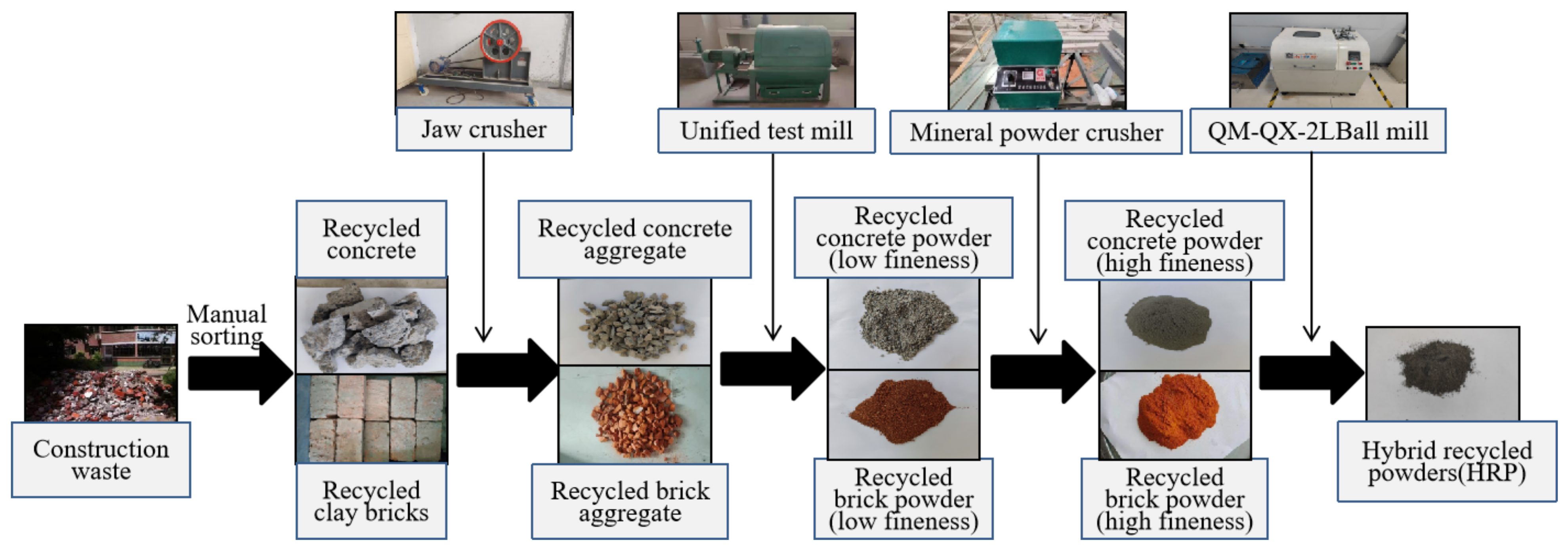
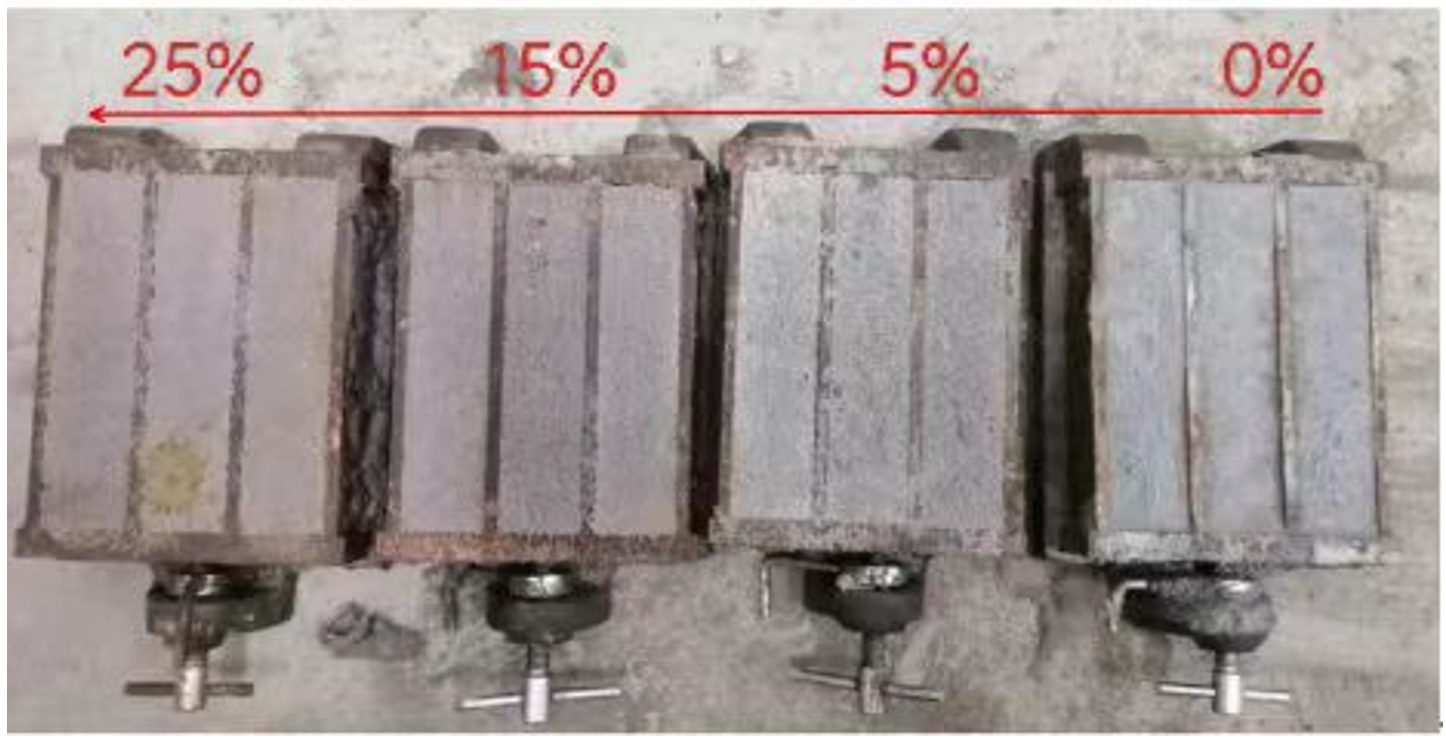
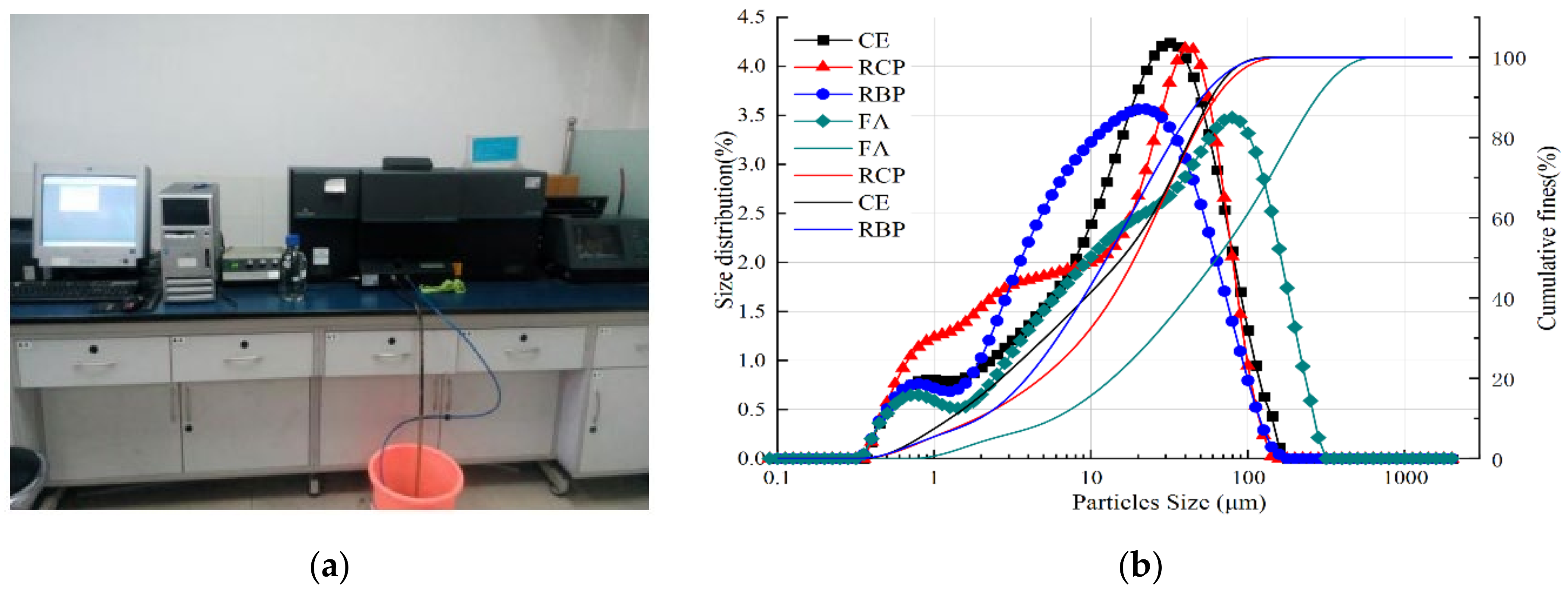
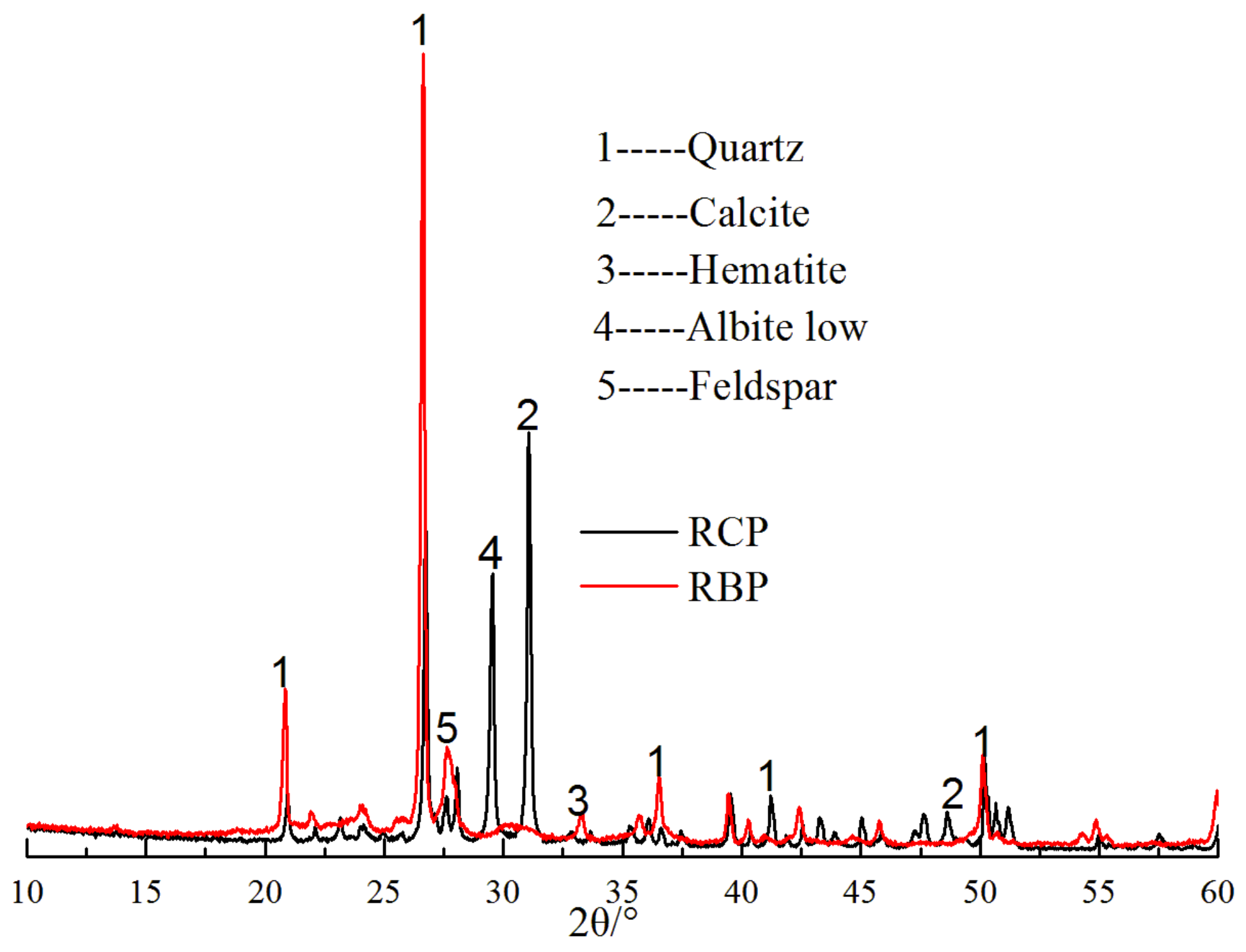
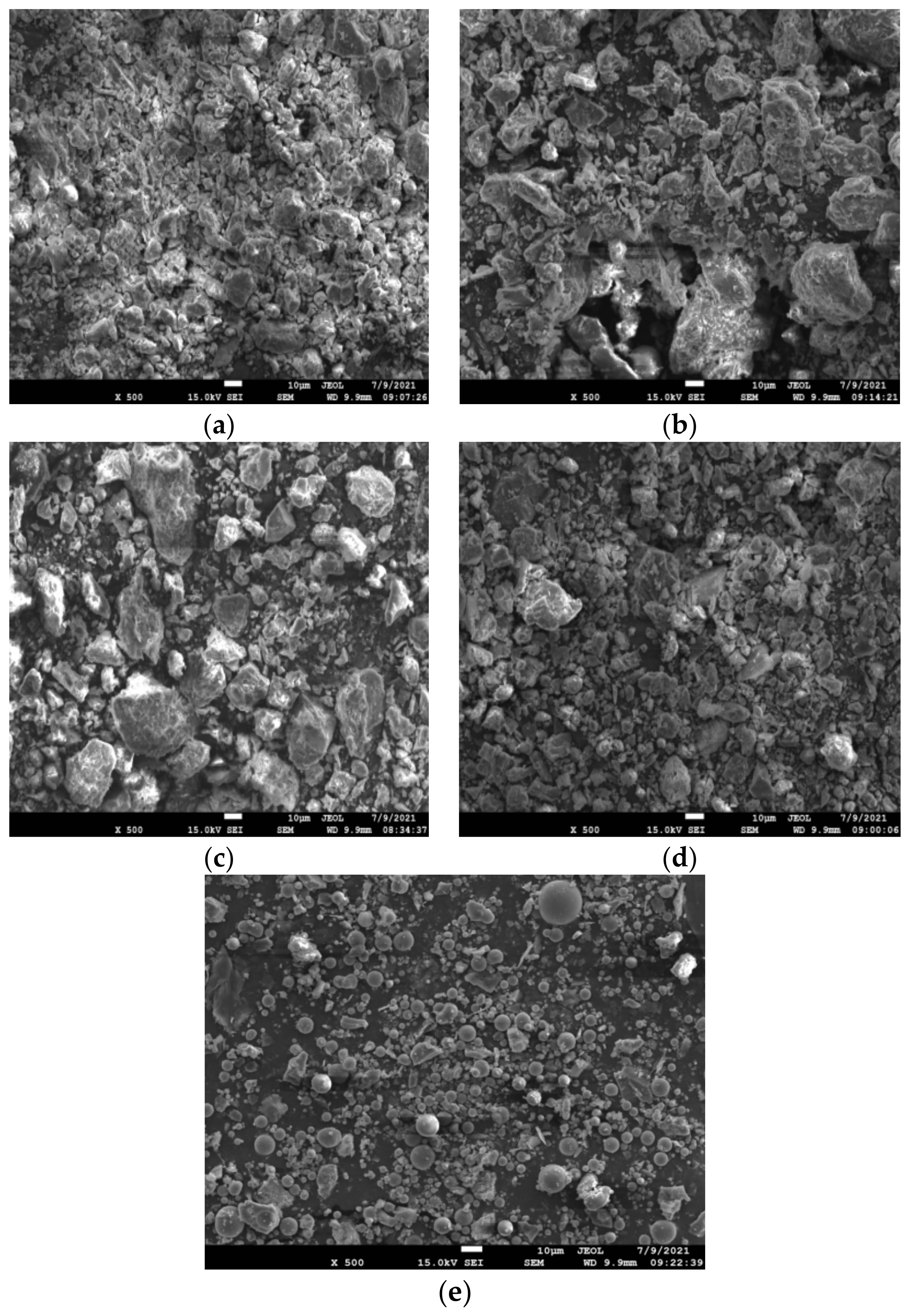
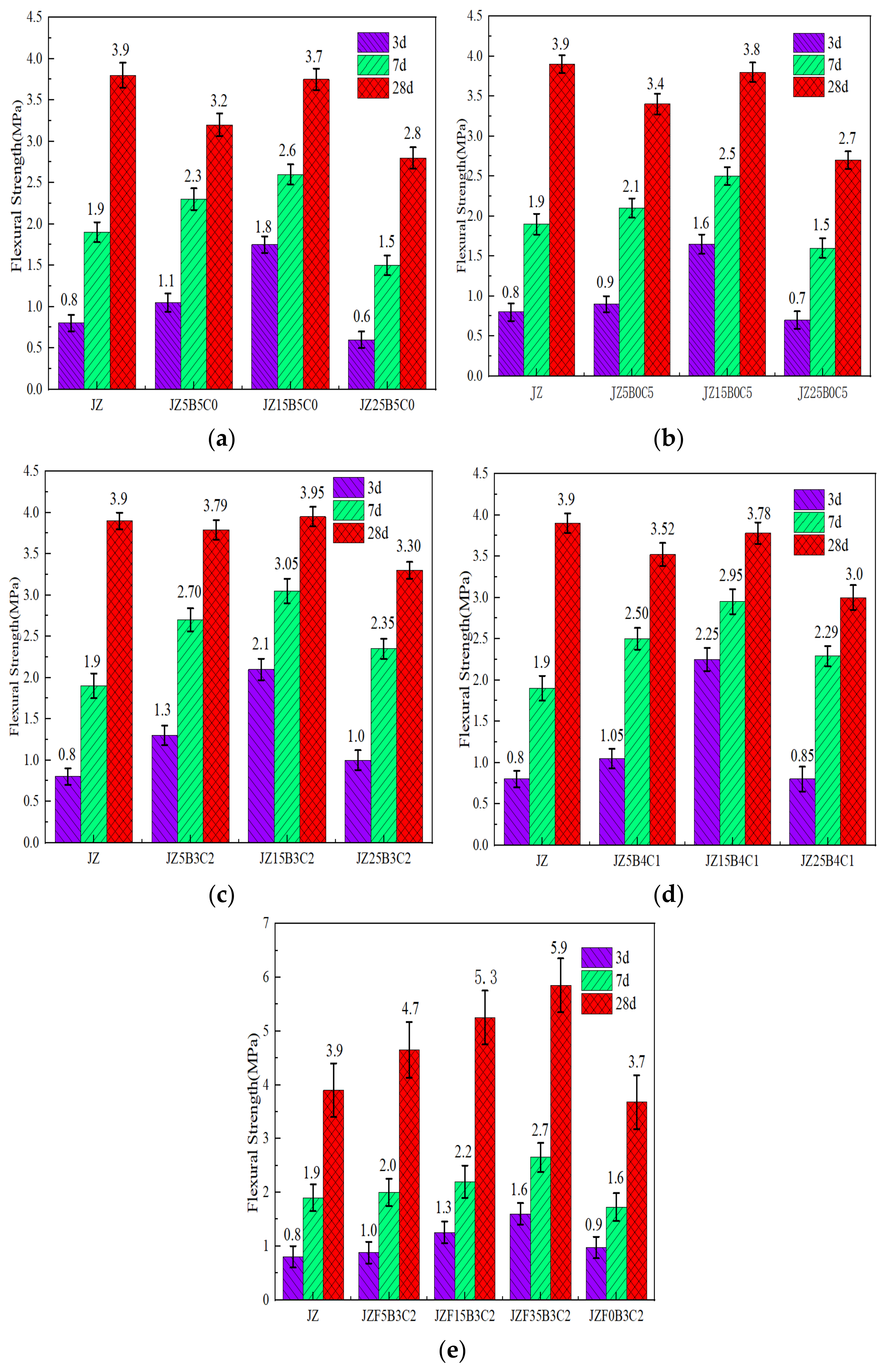


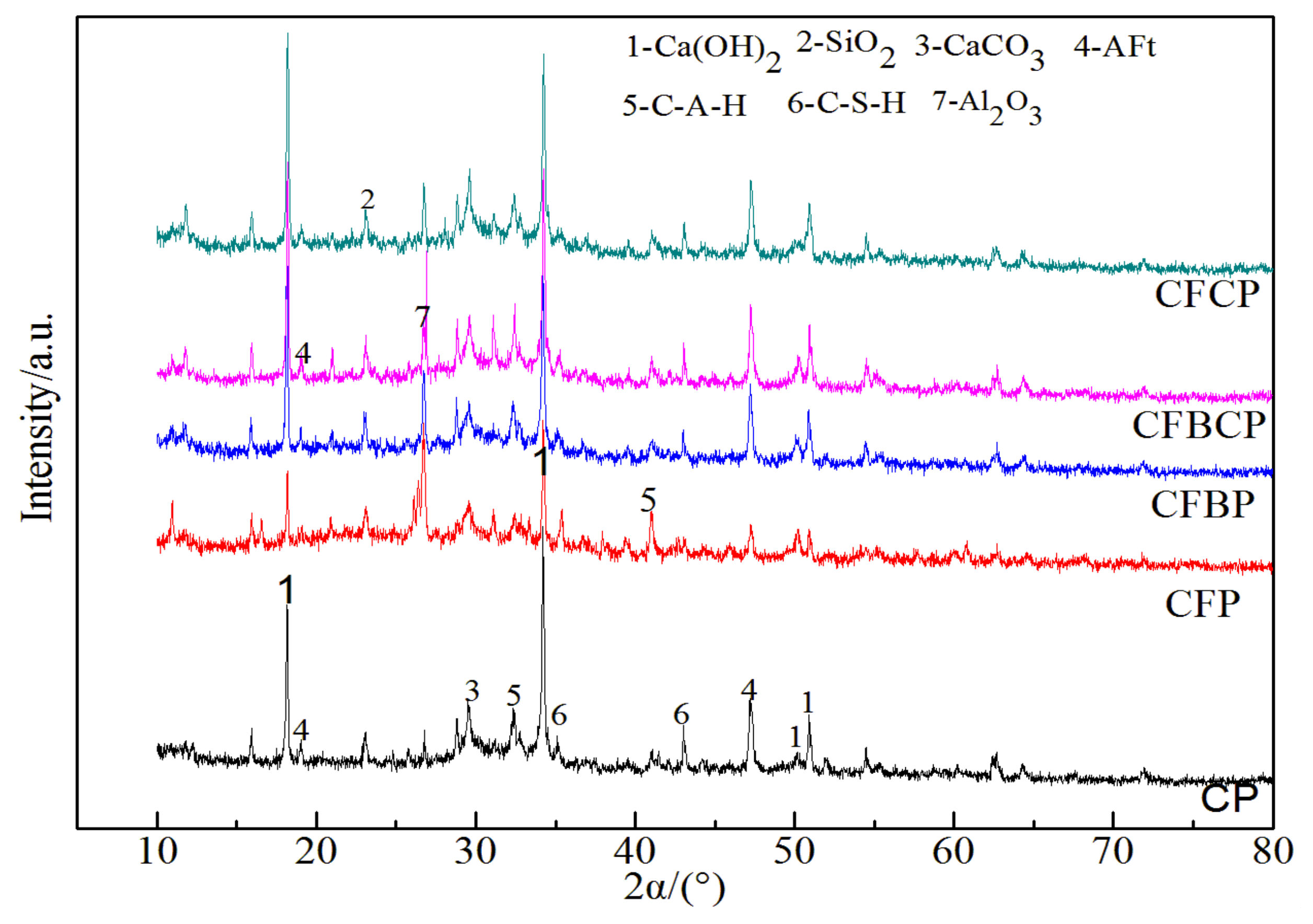
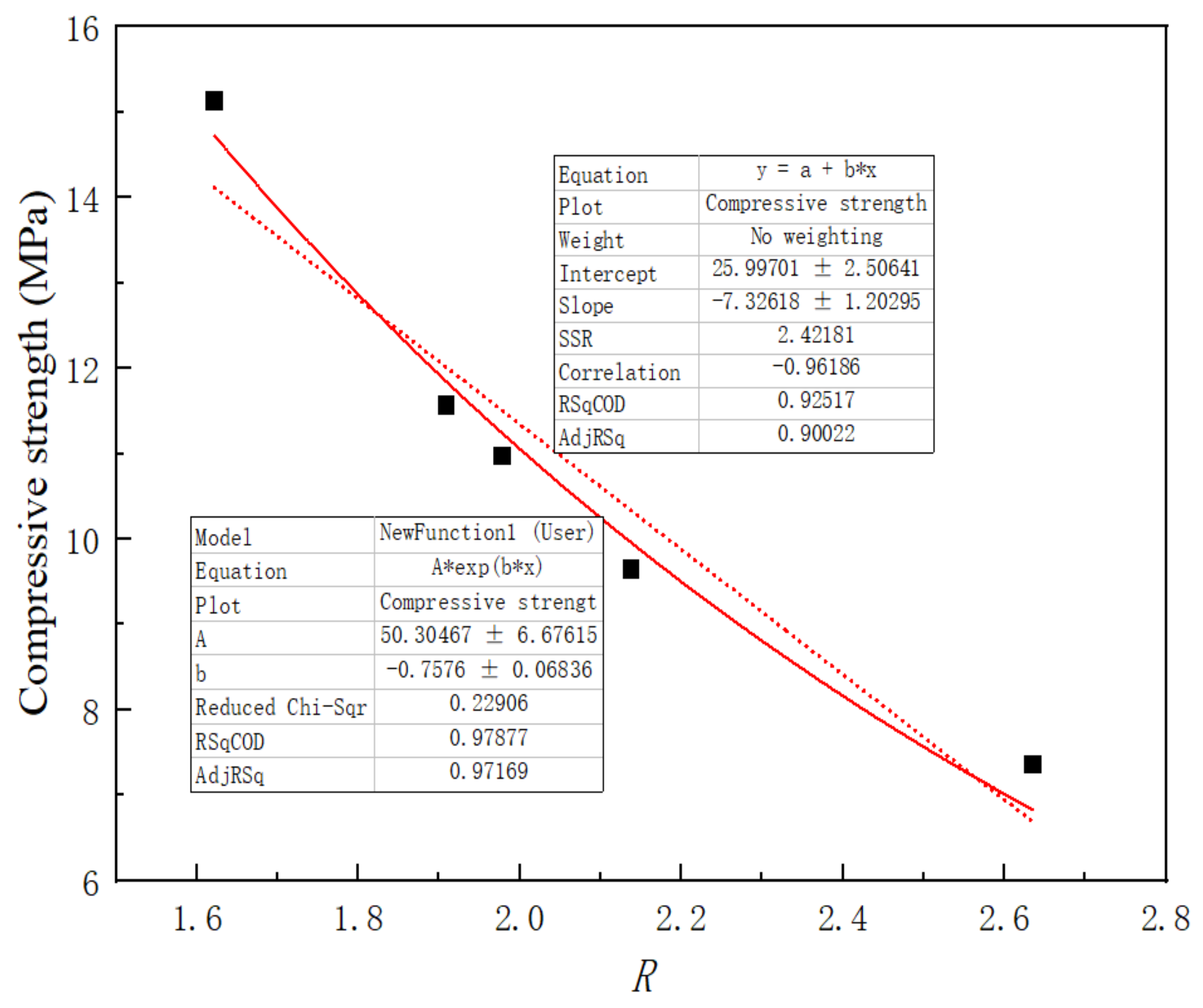
| Type | Replacement Rate | Cement | HRP (RBP:RCP)/(kg/m3) | Fly Ash | |||||
|---|---|---|---|---|---|---|---|---|---|
| 5:0 | 4:1 (HRP-II) | 3:2 (HRP-I) | 0:5 | ||||||
| JZ | 0 | 185.30 | - | - | - | - | - | - | 264.70 |
| JZ5BxCy | 5% | 176.04 | 9.27 | 7.42 | 1.85 | 5.56 | 3.71 | 9.27 | 264.70 |
| JZ15BxCy | 15% | 157.51 | 27.80 | 22.24 | 5.56 | 16.68 | 11.12 | 27.80 | 264.70 |
| JZ25BxCy | 25% | 138.98 | 46.33 | 37.06 | 9.27 | 27.80 | 18.53 | 46.33 | 264.70 |
| JZF5 | 5% | 185.30 | - | - | - | 7.94 | 5.29 | - | 251.47 |
| JZF15 | 15% | 185.30 | - | - | - | 23.82 | 15.88 | - | 225.00 |
| JZF35 | 35% | 185.30 | - | - | - | 55.59 | 37.06 | - | 172.06 |
| JZF100 | 100% | 185.30 | - | - | - | 158.82 | 105.88 | - | 0 |
| Material Type | Chemical Composition and Content (wt%) | |||||||
|---|---|---|---|---|---|---|---|---|
| CaO | SiO2 | MgO | Al2O3 | Fe2O3 | K2O | Na2O | SO3 | |
| Cement | 52.30 | 21.09 | 1.20 | 5.00 | 3.89 | 0.68 | 0.39 | 2.70 |
| Fly ash | 4.15 | 62.4 | 0.55 | 23.7 | 6.89 | 0.97 | 1.23 | / |
| RBP | 3.11 | 60.92 | 1.98 | 17.44 | 5.58 | 3.14 | 2.40 | 0.081 |
| RCP | 21.74 | 47.86 | 2.67 | 10.07 | 4.41 | 1.38 | 0.489 | 1.29 |
| Type | CH (18.1°) | CH (34.0°) | SiO2 (26.7°) | R Value | Compressive Strength (MPa) |
|---|---|---|---|---|---|
| CP | 288 | 240 | 188 | 1.622 | 15.12 |
| CFBP | 522 | 330 | 426 | 2.138 | 9.64 |
| CFCP | 460 | 314 | 482 | 1.979 | 10.97 |
| CFBCP | 428 | 303 | 362 | 1.909 | 11.56 |
| CFP | 507 | 260 | 697 | 2.635 | 7.36 |
Disclaimer/Publisher’s Note: The statements, opinions and data contained in all publications are solely those of the individual author(s) and contributor(s) and not of MDPI and/or the editor(s). MDPI and/or the editor(s) disclaim responsibility for any injury to people or property resulting from any ideas, methods, instructions or products referred to in the content. |
© 2023 by the authors. Licensee MDPI, Basel, Switzerland. This article is an open access article distributed under the terms and conditions of the Creative Commons Attribution (CC BY) license (https://creativecommons.org/licenses/by/4.0/).
Share and Cite
Deng, M.; Xie, X.; Zhuo, J.; He, Y.; Wang, K. Experimental Study on the Strength and Hydration Products of Cement Mortar with Hybrid Recycled Powders Based Industrial-Construction Residue Cement Stabilization of Crushed Aggregate. Materials 2023, 16, 4233. https://doi.org/10.3390/ma16124233
Deng M, Xie X, Zhuo J, He Y, Wang K. Experimental Study on the Strength and Hydration Products of Cement Mortar with Hybrid Recycled Powders Based Industrial-Construction Residue Cement Stabilization of Crushed Aggregate. Materials. 2023; 16(12):4233. https://doi.org/10.3390/ma16124233
Chicago/Turabian StyleDeng, Miaoyi, Xiangbing Xie, Jingbo Zhuo, Yahui He, and Kaiwei Wang. 2023. "Experimental Study on the Strength and Hydration Products of Cement Mortar with Hybrid Recycled Powders Based Industrial-Construction Residue Cement Stabilization of Crushed Aggregate" Materials 16, no. 12: 4233. https://doi.org/10.3390/ma16124233
APA StyleDeng, M., Xie, X., Zhuo, J., He, Y., & Wang, K. (2023). Experimental Study on the Strength and Hydration Products of Cement Mortar with Hybrid Recycled Powders Based Industrial-Construction Residue Cement Stabilization of Crushed Aggregate. Materials, 16(12), 4233. https://doi.org/10.3390/ma16124233






